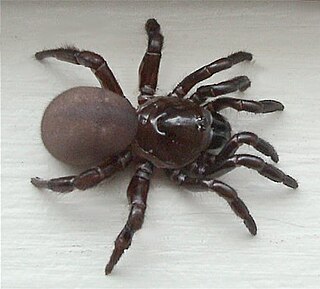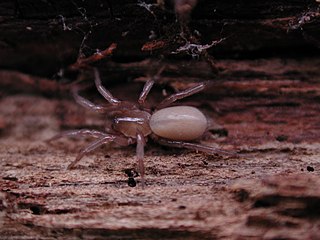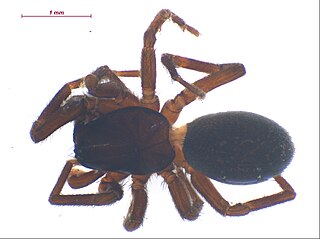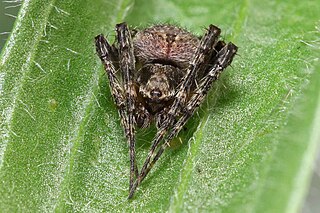
Dictynidae is a family of cribellate, hackled band-producing spiders first described by Octavius Pickard-Cambridge in 1871. Most build irregular webs on or near the ground, creating a tangle of silken fibers among several branches or stems of one plant.

Habronattus is a genus in the family Salticidae native to North America. They are commonly referred to as paradise spiders due to their colorful courtship ornaments and complex dances, similar to birds-of-paradise.
Mallos is a genus of cribellate araneomorph spiders in the family Dictynidae, and was first described by O. Pickard-Cambridge in 1902. Among the genus, Mallos gregalis is known to be a social spider species, living in groups and signaling each other by vibrating their web.

Psilochorus is a genus of spiders in the family Pholcidae.

Ummidia is a genus of mygalomorph spiders in the family Halonoproctidae, and was first described by Tamerlan Thorell in 1875.

Brommella is a genus of cribellate araneomorph spiders in the family Dictynidae, and was first described by Albert Tullgren in 1948.

Cicurina, also called the cave meshweaver, is a genus of dwarf sheet spiders that was first described by Anton Menge in 1871. Originally placed with the funnel weavers, it was moved to the Dictynidae in 1967, then to the Hahniidae in 2017. The name is from the Latin root "cucur-", meaning "to tame".

Dictyna is a genus of cribellate araneomorph spiders in the family Dictynidae, and was first described by Carl Jakob Sundevall in 1833.
Kibramoa is a genus of North American plectreurid spiders that was first described by Ralph Vary Chamberlin in 1924.

Emblyna is a genus of cribellate araneomorph spiders in the family Dictynidae, and was first described by R. V. Chamberlin in 1948.

Lathys is a genus of cribellate araneomorph spiders in the family Dictynidae, and was first described by Eugène Simon in 1884. It is a replacement name for "Lethia" Menge, 1869 because that name was already in use as a synonym for a genus of moths.
Thallumetus is a genus of cribellate araneomorph spiders in the family Dictynidae, and was first described by Eugène Simon in 1893.
Tivyna is a genus of cribellate araneomorph spiders in the family Dictynidae, and was first described by R. V. Chamberlin in 1948.

Tricholathys is a genus of cribellate araneomorph spiders in the family Dictynidae, and was first described by R. V. Chamberlin & Wilton Ivie in 1935.

Eustala is a genus of orb-weaver spiders first described by Eugène Simon in 1895.
Eulaira is a genus of North American dwarf spiders that was first described by Ralph Vary Chamberlin & Vaine Wilton Ivie in 1933.

Grammonota is a genus of dwarf spiders that was first described by James Henry Emerton in 1882.












